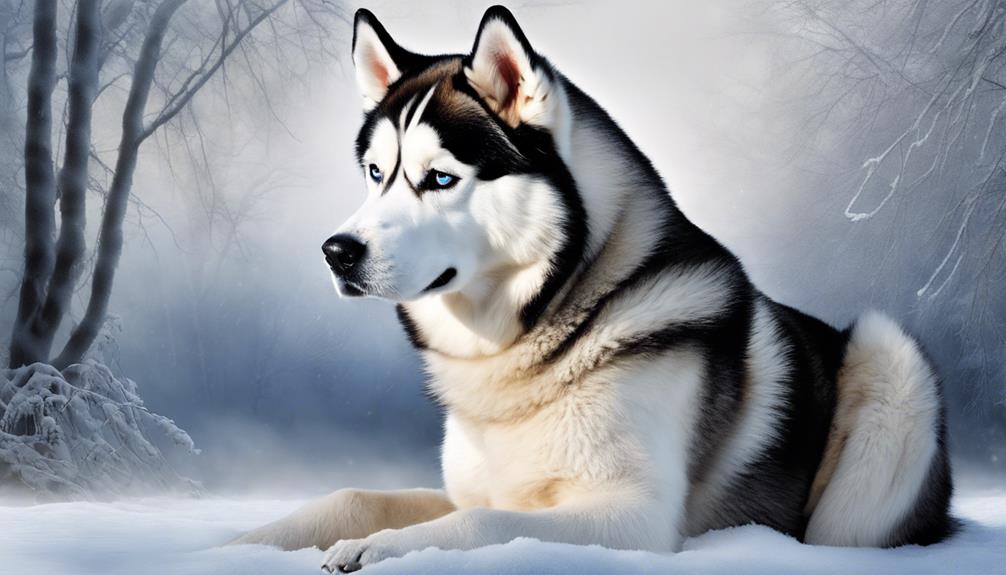Dogs sniff everything because their incredible sense of smell is far superior to ours. With around 220 million scent receptors and an olfactory cortex that's 40 times larger than humans', they can detect scents in parts per trillion. Sniffing helps them gather information about their surroundings and understand the world through odor. It's not just instinct; it's essential for their happiness and well-being. There's so much more to uncover about this fascinating behavior.
Key Takeaways
- Dogs sniff everything to gather information about their environment, as their sense of smell is far superior to other senses.
- With 220 million scent receptors, dogs can detect complex odors, including those linked to health and emotions.
- Sniffing provides essential mental stimulation, which is crucial for a dog's quality of life and overall happiness.
- Engaging in sniff walks allows dogs to explore at their own pace, promoting a sense of control and reducing stress.
- The act of sniffing releases dopamine in dogs, enhancing their mood and strengthening the bond with their owners.
A Dog's Primary Sense
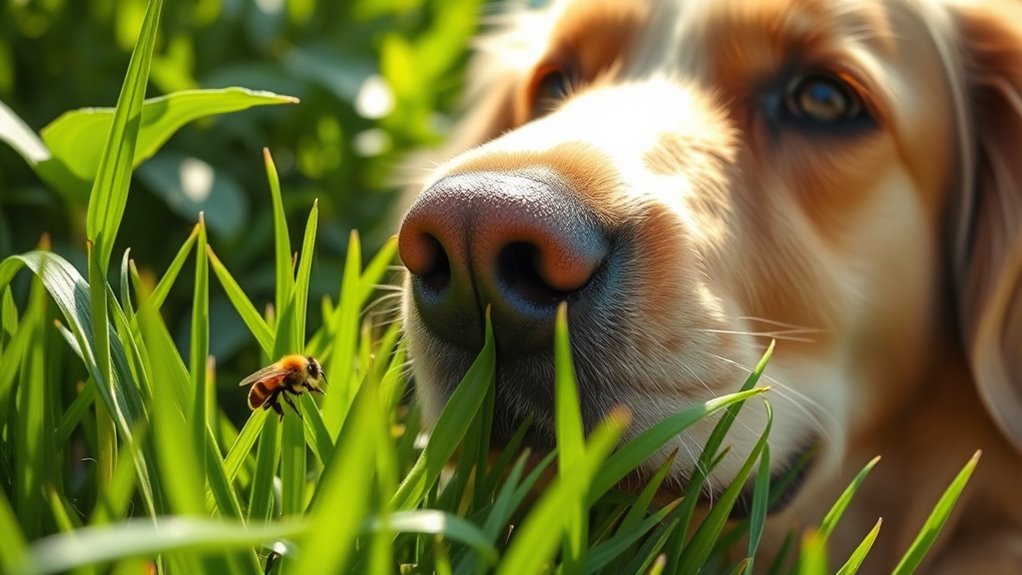
Dogs have an incredible superpower: their sense of smell. This superior sense of smell allows dogs to navigate their world far better than sight, sound, or touch.
With 100 million to 300 million scent receptors, dogs can detect odors in parts per trillion, making their sniffing abilities 40 times more powerful than yours. When dogs sniff, they're gathering essential information about their surroundings and each other.
Dogs love to sniff during their daily adventures, often taking sniff breaks to fully explore scents. Their brains are wired for this, with one-eighth dedicated to interpreting odors.
Plus, the vomeronasal organ helps dogs in detecting pheromones, important for social interactions. So, the next time your dog sniffs everything, remember, it's their primary sense at work!
The Nose Knows
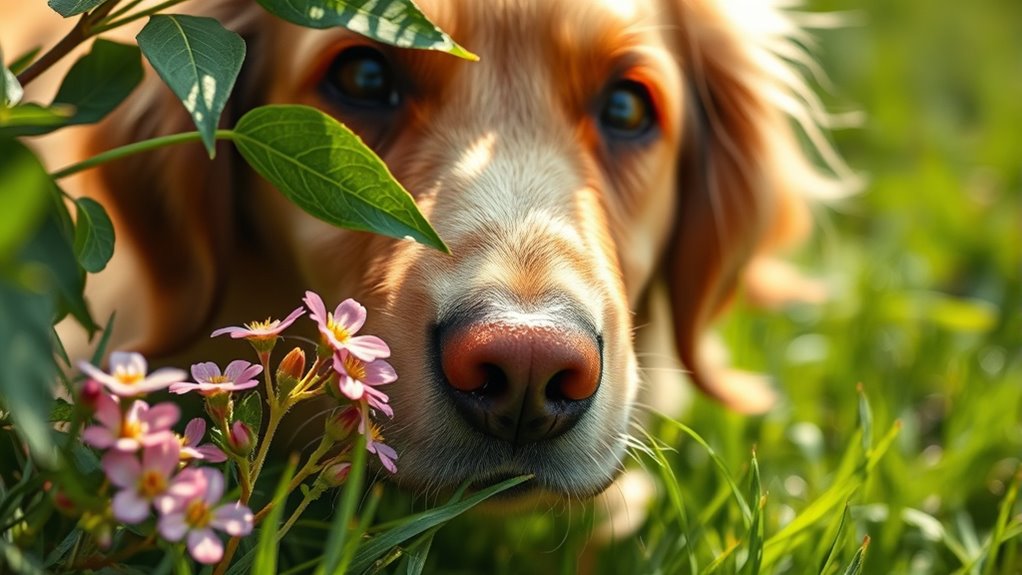
With their remarkable sense of smell, dogs can unravel a world of information through their noses. They possess around 220 million scent receptors, allowing them to sniff out odors at least 1,000 times better than you can.
Their olfactory cortex is 40 times larger than yours, dedicating one-eighth of their brain to interpreting scents. This enables dogs to identify smells in parts per trillion and recognize complex odors linked to health, emotions, and even other animals' identities.
The vomeronasal organ enhances their ability to detect pheromones, essential for communication and social interactions.
When dogs sniff, they're not just exploring; they're engaging in mental stimulation, processing a rich tapestry of scents that reveals so much about their environment.
Wired for Smell

The incredible anatomy of a dog's nose is specifically designed for smell, giving them an unparalleled advantage in scent detection.
The unique structure of a dog's nose is masterfully crafted for exceptional scent detection capabilities.
When you see dogs sniffing, remember they're using their brains to analyze the world around them.
Here are three fascinating facts about their olfactory powers:
- Dogs have an olfactory cortex 40 times larger than humans', allowing them to process smells with remarkable efficiency.
- With over 220 million scent receptors, they can detect odors at least 1,000 times better than you can.
- The vomeronasal organ enhances their ability to detect pheromones, vital for understanding dogs' body language during social interactions. Additionally, dogs can identify specific scents used in search and rescue operations, showcasing their incredible abilities.
Meet Your Dog's Need to Sniff
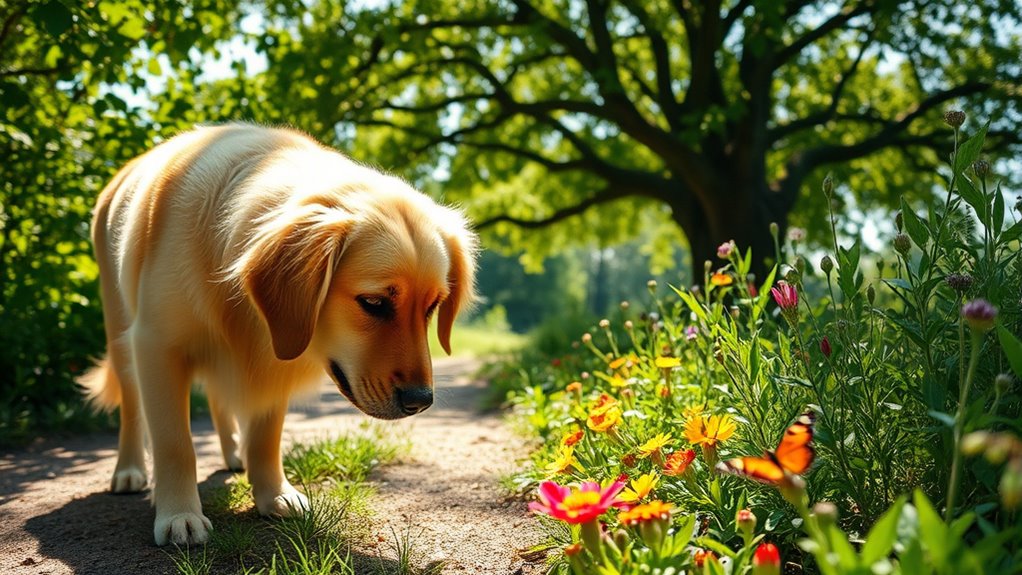
Sniffing isn't just a quirky behavior—it's an essential part of your dog's experience in the world. Dogs love to sniff everything because it's their primary way of gathering information.
With around 220 million scent receptors, they detect scents far better than we can. Meeting their need for sniffing isn't just fun; it provides crucial mental stimulation that enhances their quality of life. Budgeting for pet care can help ensure you have the resources to provide enriching experiences for your dog.
Incorporating structured sniff walks into your routine can satisfy their natural instinctual needs while allowing them to explore their environment. During these walks, let your dog choose their direction and duration at each scent.
This not only satisfies their curiosity but also promotes a sense of control, keeping them happy and engaged.
Benefits of Sniff Time for Dogs

While you might see your dog sniffing everything in sight as mere curiosity, it's actually an important activity that offers numerous benefits.
Here are three key advantages to evaluate:
- Mental Stimulation: With over 200 million scent receptors, sniffing provides dogs with unparalleled sensory information, equating 20 to 30 minutes of sniffing to an hour of brisk walking.
- Happiness and Reducing Stress: Sniffing releases dopamine, promoting feelings of happiness and alleviating anxiety, which is crucial for nervous dogs.
- Enhanced Exploration: Allowing your dog to stop and sniff, like sniffing a tree, enriches their experience, strengthening your bond through shared exploration. Additionally, spending time outdoors can connect your dog with eco-friendly excursions, enhancing their overall well-being and happiness.
Managing Dog Sniffing Behavior
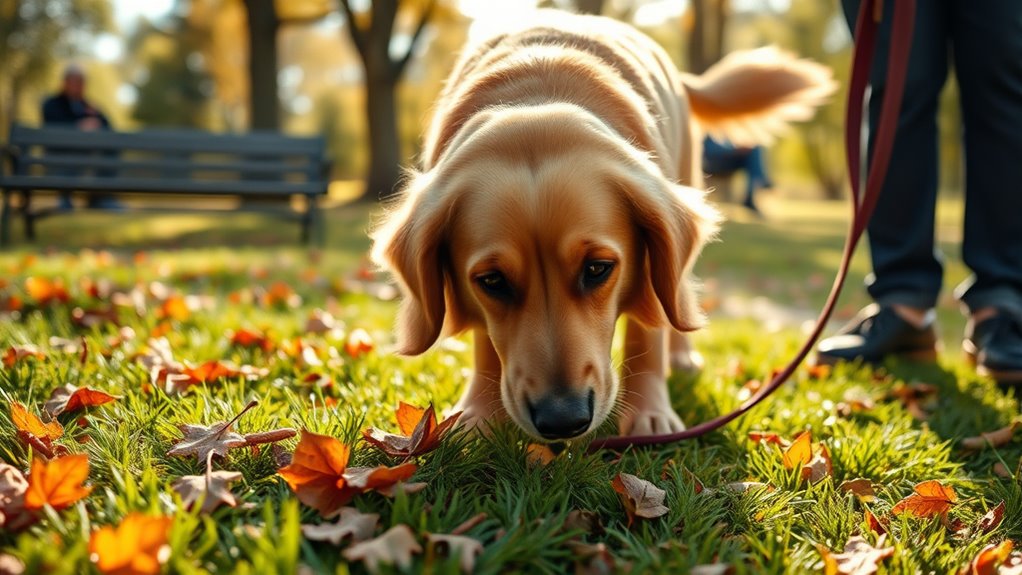
When managing your dog's sniffing behavior, it is essential to strike a balance between allowing natural exploration and maintaining control during walks. Use commands like "Walk on" to redirect your dog's attention when sniffing becomes excessive. Consistent training with positive reinforcement, such as treats or praise, encourages focus. Teaching dogs to greet humans by sniffing hands rather than other areas can also help manage their behavior in social situations.
| Control Methods | Description |
|---|---|
| Shorter Leash | Provides better control |
| Positive Reinforcement | Encourages desired behavior |
| Consistent Training | Establishes proper habits |
| Redirecting Attention | Keeps walks enjoyable |
With these strategies, you can effectively manage your dog's sniffing habits.
Frequently Asked Questions
What Does It Mean When Your Dog Sniffs Everything?
When your dog sniffs everything, it's exploring its environment and gathering important information.
This behavior means your furry friend is picking up details about other animals, such as their age and health, through scent.
It's also a way for your dog to communicate and understand its surroundings better.
Sniffing provides mental stimulation, helping to keep your pup engaged and satisfied.
What Is 10 Minutes of Sniffing for Dogs Equivalent To?
Ten minutes of sniffing for your dog is equivalent to an hour of vigorous physical exercise.
This mental workout engages a significant part of their brain, allowing them to gather essential information about their surroundings.
By letting your dog sniff, you're providing them with not only mental stimulation but also a chance to release dopamine, which promotes happiness and relaxation.
Should I Let My Dog Sniff Everywhere?
Letting your dog sniff everywhere is like giving them a treasure map to explore their world. You should absolutely allow it, as sniffing provides crucial mental stimulation and happiness.
It's their way of gathering information about their surroundings and learning about other animals. Just keep an eye on them; while sniffing is important, balancing it with your walk's structure can help maintain focus and guarantee a satisfying experience for both of you.
At What Age Do Dogs Stop Sniffing Everything?
Dogs don't stop sniffing everything at a specific age. Instead, their sniffing behavior is instinctual and continues throughout their lives.
While puppies might sniff more due to curiosity, adult dogs still rely on their sense of smell for information.
You'll notice that as your dog matures, they might focus on certain scents more, but they'll always enjoy exploring the world through their nose.
Conclusion
So, next time you take your dog for a walk, embrace the sniffing. Let them explore the world through their nose, discover new scents, and connect with their surroundings. Remember, every sniff is a story, every pause is a moment, and every wag of their tail is a joy. By understanding their need to sniff, you're not just allowing them to be a dog; you're giving them the freedom to experience life in a whole new way.






